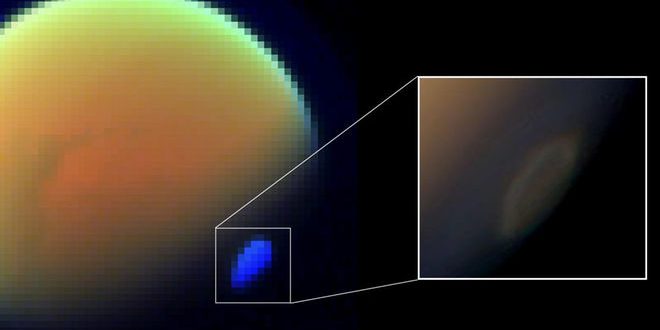NASA’s Cassini spacecraft has discovered a strange cloud on Titan that goes against everything scientists thought they knew about the moon’s atmosphere.
Years ago, when Voyager 1 spotted the first ice cloud on Titan made from a compound of carbon and nitrogen known as dicyanoacetylene (C4N2), researchers calculated that there needed to be at least 100 times more C4N2 gas to produce it. They postulated that perhaps the gas was indeed there but Voyager’s instruments simply weren’t strong enough to pick it up.
But Cassini has much more sensitive equipment and, when its composite infrared spectrometer (CIRS) instrument also saw a C4N2 cloud with no accompanying vapor in Titan’s troposphere, a new theory was called for.
That theory has been put forth in a paper published in the journal Geophysical Research Letters and detailed in a NASA press release issued today.
The theory involves what’s known as “solid state chemistry,” as the cloud-formation process starts with solids rather than gases.
In this theory, grains of ice form from a chemical known as cyanoacetylene (HC3N). As the grains fall downward through Titan’s stratosphere they get encased in a shell of ice comprised of hydrogen cyanide (HCN).
“Occasionally, a photon of ultraviolet light tunnels into the frozen shell and triggers a series of chemical reactions in the ice,” says NASA. “These reactions could begin either in the core or within the shell. Both pathways can yield dicyanoacteylene ice and hydrogen as products.”
This would explain the way in which a vaporless cloud could form.
The process is similar to one that happens on Earth and, was indeed one from which the researchers took their inspiration.
Similar to Titan, our stratosphere is also moisture poor yet sometimes features known as nacreous clouds are formed there when ice crystals act as seeds around which chlorine-bearing chemicals attach. The union creates a chemical reaction, forming the cloud and releasing chlorine molecules that degrade our ozone layer. The cloud is effectively formed chemically, without condensation, just like on Titan.
“The compositions of the polar stratospheres of Titan and Earth could not differ more,” said Michael Flasar, CIRS principal investigator at NASA’s Goddard Space Flight Center. “It is amazing to see how well the underlying physics of both atmospheres has led to analogous cloud chemistry.”
“It’s very exciting to think that we may have found examples of similar solid-state chemical processes on both Titan and Earth,” added Carrie Anderson, a CIRS co-investigator and lead author of the study.
Agencies/Canadajournal
 Canada Journal – News of the World Articles and videos to bring you the biggest Canadian news stories from across the country every day
Canada Journal – News of the World Articles and videos to bring you the biggest Canadian news stories from across the country every day



